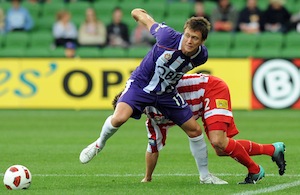
Better late than never, but is it too late to rescue the perception that pervades in the broader community that the standard of the A-League is average? That’s how a friend, on the weekend, assessed the popular theory being espoused that the standard of the competition has lifted this season.
Everyone has been jumping on the bandwagon, talking up the improved standard of the competition. “When one person says it, they all say it,” was how he summed it up.
There’s no doubt the theory is accurate.
Spurred by the influx of some positive foreign managers, all trying to play the game in the proactive way (take a bow John van’t Schip, Rini Coolen and Franz Straka), and the locals keeping up with the Jones’, the standard this season has taken another giant leap, its biggest yet.
But largely ignored has been the fact that there was a vast improvement in the technical standards last season, from a dire season four to a vibrant and very watch-able season five.
It all started, to my mind, with the arrival of Vitezslav Lavicka to our shores. Instilling a professional and humble attitude throughout the club, Sydney FC dished up a tactically organised and technical sophisticated brand built on transition, both into defence and offence.
The fact their conservative style has been left behind this season is a sign that the bar has been lifted even further, as if Steven Hooker or Sergey Bubka just joined the competition.
The reality, last season, is that Sydney weren’t the only team performing, with at least four others (50 percent of the competition), in Wellington Phoenix, Melbourne Victory, Gold Coast United and the Newcastle Jets dishing up some very watch-able football.
Even Perth Glory, towards the end of the campaign, were worth catching, while Adelaide United’s form in the final third of the season was certainly the antithesis to what we’d seen in the first two-thirds of the regular season.
The likes of Mathew Leckie and Michael Marrone were catching the eye well before Christmas.
Little wonder I was able to come up with these lists in summarising the season.
The unfortunate thing though was that there were very few out there recognising the quality of last season, let alone spreading the message.
It was all about the issues and off field problems.
Even within the governing body, it was invariably reactionary. While attention was no doubt consumed by the World Cup bid, there was no-one out there assessing the standard of the competition, telling Joe Public about the vast improvement from season four to five, managing the media, both football and wider, in a proactive manner.
With the national manager of the time, Pim Verbeek, off in Europe preparing for the World Cup, missing the opening two months of the season, who was on the front foot?
Instead Verbeek’s season four comments about the standard of the competition, true at the time, stuck. The perception was there.
When News Limited went to town, early last season, on the declining crowds, who was out there talking up the improved standard, how the league was finally worth watching? Who was providing the honest assessment?
Instead the league was getting a hiding, from all and sundry; the national manger, the mainstream media and the football media, bloggers, columnists and TV pundits alike.
Perhaps, as it’s been put to me by more than one close observer, they simply didn’t know, and wouldn’t know, that standards were on the rise, right in front of their eyes.
It is a theory which has some merit.
I laughed this week at the suggestion by Frank Lowy that the Sydney crowds have stopped showing up because of their fickle nature and poor results. More spin.
Even last season, with the team playing swashbuckling football at the SFS, the crowds really didn’t respond in great numbers. But for the 25,000 that showed up for the premiership decider, SFS crowds hovered between 10,000 and 15,000 all season.
Hard to shake off the perception.
When the A-League kicked off in 2005, fans were promised “new football”, exciting football. Football fans were urged to back it and show the faith.
No doubt enticed by the perception of being part of something fresh, they did, giving the league its early impetus.
The pity was that the standard, for the first four seasons, was rather dire in most pockets, but for the odd bit of sparkle from the Central Coast Mariners (season one), the Victory (seasons two and four) and the Jets (seasons two and three).
Too often though the league, in its early years, was the domain of dud managers, dud recruits, dud tactics and dud technical decisions, all for an absolute premium as ticket prices rose year on year.
It was little wonder then that the fans, many of them long time football followers, many new, walked away.
The irony now is that the technical standards are up, perhaps where they should have been at the beginning. Had that been the case, the enticed fans might have stuck around.
But with the game buried on pay TV for at least a couple more years (Fox could help its own cause and that of the league by on-selling a game a week – Friday night – to OneHD, and the FFA could help by facilitating such a move, if it isn’t already) and the honeymoon with the mainstream press and broader community well and truly over, there is much rebuilding to be done.
Foremost is the need get the mainstream media on side, manage the message in a proactive and honest way and get some of the goodwill back. But that will take plenty of know-how and attention to detail.





























































































